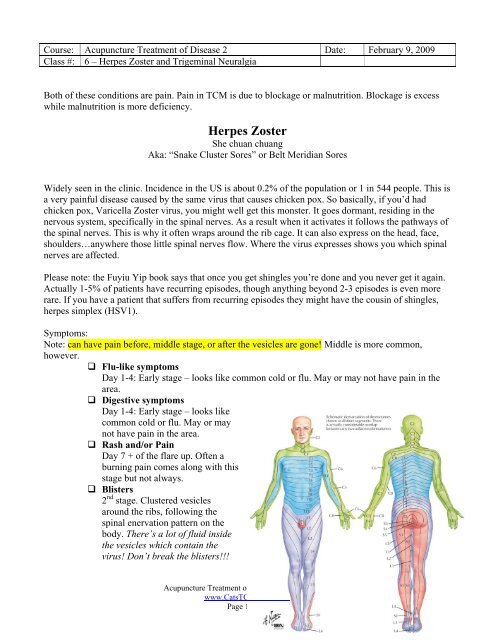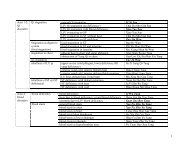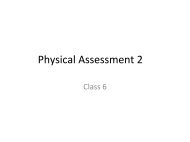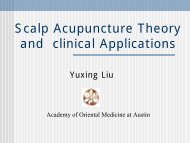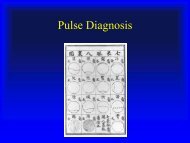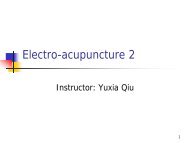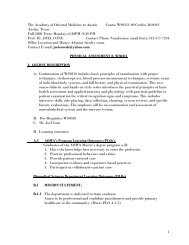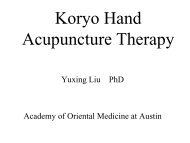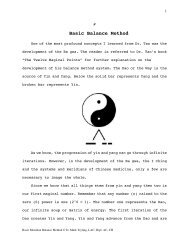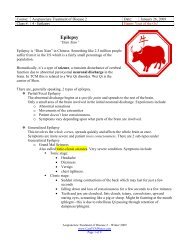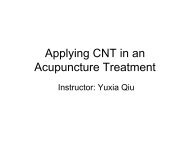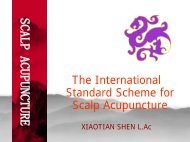Course: - CatsTCMNotes
Course: - CatsTCMNotes
Course: - CatsTCMNotes
Create successful ePaper yourself
Turn your PDF publications into a flip-book with our unique Google optimized e-Paper software.
<strong>Course</strong>: Acupuncture Treatment of Disease 2 Date: February 9, 2009<br />
Class #: 6 – Herpes Zoster and Trigeminal Neuralgia<br />
Both of these conditions are pain. Pain in TCM is due to blockage or malnutrition. Blockage is excess<br />
while malnutrition is more deficiency.<br />
Herpes Zoster<br />
She chuan chuang<br />
Aka: “Snake Cluster Sores” or Belt Meridian Sores<br />
Widely seen in the clinic. Incidence in the US is about 0.2% of the population or 1 in 544 people. This is<br />
a very painful disease caused by the same virus that causes chicken pox. So basically, if you’d had<br />
chicken pox, Varicella Zoster virus, you might well get this monster. It goes dormant, residing in the<br />
nervous system, specifically in the spinal nerves. As a result when it activates it follows the pathways of<br />
the spinal nerves. This is why it often wraps around the rib cage. It can also express on the head, face,<br />
shoulders…anywhere those little spinal nerves flow. Where the virus expresses shows you which spinal<br />
nerves are affected.<br />
Please note: the Fuyiu Yip book says that once you get shingles you’re done and you never get it again.<br />
Actually 1-5% of patients have recurring episodes, though anything beyond 2-3 episodes is even more<br />
rare. If you have a patient that suffers from recurring episodes they might have the cousin of shingles,<br />
herpes simplex (HSV1).<br />
Symptoms:<br />
Note: can have pain before, middle stage, or after the vesicles are gone! Middle is more common,<br />
however.<br />
Flu-like symptoms<br />
Day 1-4: Early stage – looks like common cold or flu. May or may not have pain in the<br />
area.<br />
Digestive symptoms<br />
Day 1-4: Early stage – looks like<br />
common cold or flu. May or may<br />
not have pain in the area.<br />
Rash and/or Pain<br />
Day 7 + of the flare up. Often a<br />
burning pain comes along with this<br />
stage but not always.<br />
Blisters<br />
2 nd stage. Clustered vesicles<br />
around the ribs, following the<br />
spinal enervation pattern on the<br />
body. There’s a lot of fluid inside<br />
the vesicles which contain the<br />
virus! Don’t break the blisters!!!<br />
Acupuncture Treatment of Disease 2 – Winter 2009<br />
www.<strong>CatsTCMNotes</strong>.com<br />
Page 1 of 12
Will infect other parts of the skin that it touches.<br />
Post-herpetic neuralgia<br />
The rashes and blisters dry up after a while – how long depends on patient. This is when<br />
the pain sets in usually. Pain along the ribs, following the spinal nerves as they wrap<br />
around the body. See the dermatome map to the right on the previous page. This pain can<br />
last for years – neuralgia. Very little will make it feel better.<br />
Disease is characterized by painful skin lesions, trunk, face, mouth. Complications include headache,<br />
vomiting, fever, meningitis. Recovery can take 5 weeks+. Click here for a fun website about this<br />
disease.<br />
The Yip/Wu book chart the symptoms this way:<br />
Day Eruption phase Symptoms<br />
Day 1-4 Prior to eruption ☯ Flu-like symptoms:<br />
chills, fever, headaches, fatigue<br />
☯ Digestive symptoms:<br />
nausea, vomiting, decreased appetite,<br />
loose stools or diarrhea, abdominal<br />
cramps. Remember that dampness<br />
attacks digestive organs first.<br />
☯ Pain:<br />
May or may not have pain<br />
Day 5-9 Eruption ☯ Crops of clustered vesicles<br />
o Vesicles containing serous fluid<br />
distributed in bands and<br />
erythema along the dermatome<br />
nerve pathways.<br />
o Clusters usually on the lower<br />
back, hypochondriac region,<br />
forehead, outer canthus, but can<br />
be anywhere the spinal nerves<br />
go.<br />
o Usually unilateral<br />
☯ Pain:<br />
Probably will have pain, but may not.<br />
Day 10-21 + Post-eruption ☯ Fluid in the vesicles becomes cloudy,<br />
vesicles dry out and scab. Coloration<br />
may be dark red/purple in the area.<br />
☯ Pain<br />
Following<br />
months/years<br />
Post-eruption and<br />
skin clearing<br />
☯ 15% of patients get pain only, no skin<br />
manifestations.<br />
Acupuncture Treatment of Disease 2 – Winter 2009<br />
www.<strong>CatsTCMNotes</strong>.com<br />
Page 2 of 12
TCM Etiology<br />
This is a latent virus. How to explain this in TCM?<br />
Heat is an external Yang pathogen while Dampness is an internal Yin pathogen. The heat<br />
normally wants to exit the body but dampness, being a sticky pathogen, holds it inside. This<br />
results in a half-exterior/half-interior problem.<br />
If there is more dampness, the latency is more internal while if there is more heat, it is more<br />
external. The ramification of this in TCM is that it tends to affect 1) the diaphragm, the border<br />
between upper and lower jiao, 2) the dai or girdling vessel, the border between upper and lower<br />
halves of the body, and 3) the Shaoyang channel which is the ½ in- ½ out channel anyhow.<br />
You’ll see in the following information that indeed, the Gallbladder and Liver are often involved<br />
in shingles.<br />
☯ Invasion of External pathogens<br />
These are yang pathogens with triggers bringing out the latent pathogen.<br />
o Wind<br />
o Heat<br />
o Summer Heat<br />
☯ Retention of latent pathogens<br />
See discussion of latency above.<br />
o Damp heat<br />
Reflected in the red color (heat) and the vesicles (damp)<br />
o Toxic damp heat<br />
☯ Emotional disorder<br />
Liver heat and fire brings the dampness out to the superficial areas.<br />
☯ Irregular diet<br />
Can aggravate dampness and heat internally. This refers predominantly to the over-consumption<br />
of spicy foods, alcohol, and other substances that disturb the balance of yin and yang.<br />
☯ Aging<br />
Yin, Essence, and Blood deficiencies (as well as Kidney and Liver Yin Xu) result in floating<br />
Yang which allow the Yang pathogens to move from latent to active stages. And of course, with<br />
more age you have suffered more from bad diet if you live here. Ain’t America great?<br />
TCM Mechanism<br />
Retention of latent pathogens stimulated by inducing factors or Yang<br />
pathogens to move the latency to the surface/superficial areas of the<br />
body.<br />
Acupuncture Treatment of Disease 2 – Winter 2009<br />
www.<strong>CatsTCMNotes</strong>.com<br />
Page 3 of 12
Differential Diagnosis and Treatment<br />
There are both excess and deficient reasons for Shingles. Excess reasons include Liver and Gallbladder<br />
wind fire, Dai channel or Spleen damp heat/toxic heat and qi and blood stagnation. Distribution is often<br />
along the Gallbladder channel.<br />
Basic Points<br />
☯ SJ 5 + GB 41. SJ 5 dampness/heat. GB 41 is the exit point – helps the pathogen leave<br />
☯ LI 11 – heat<br />
☯ ST 40 – damp/phlegm<br />
☯ SP 10 – Clears heat in the blood, removes dampness, addresses blood/heat skin problems. Also<br />
good for stasis.<br />
☯ UB 40 – damp heat and toxic heat<br />
☯ Hua Tuo Jiaji – addresses CNS, nervous system which is infected by the herpes zoster, also Du<br />
channel.<br />
Invasion of Wind-Fire in Liver and Gallbladder<br />
(First Stage)<br />
Wind fire includes infectious, contagious, febrile and epidemic diseases.<br />
Patient will have chills and fever, more fever and less chills. Could also have emotional<br />
problems – liver/gallbladder affectation: irritable, restless, bitter taste in mouth. Superficial pulse<br />
because is wind related. Could also be wiry/fast.<br />
☯ UB 12 – wind gate<br />
Acupuncture Treatment of Disease 2 – Winter 2009<br />
www.<strong>CatsTCMNotes</strong>.com<br />
Page 4 of 12
☯ Du 14 – good with bleeding/cupping but only on the first stage. Will suck out the heat.<br />
Bleed and cup unless have the rash around this area!<br />
☯ LV 2 – clears out the heat<br />
Damp Heat or Toxic Heat in the Dai Mai or in the Spleen<br />
(Second Stage)<br />
Sharp pain, damp symptoms such as nausea, vomiting, heaviness. Tongue will be red with<br />
yellow greasy coating. Should see rash on half of the trunk. Sometimes encircles the body, but<br />
really rare for those unlucky few. These folks have most meridians involved and the whole Dai<br />
channel is thus involved.<br />
☯ Sj5 + GB 41 is first choice<br />
☯ SP 9 – damp retention<br />
☯ Dai channel points<br />
o GB 26 (“dai mai” point). Good for both shingles and gynecological diseases<br />
o Use reducing methods on these points.<br />
Qi and Blood Stagnation<br />
(Third Stage)<br />
This stage arises from the previous 2.<br />
Blisters are shrinking or gone. Might have scars and darkens, showing stasis. The marker<br />
symptoms for this stage and the manifestations of Blood Stasis in Herpes Zoster:<br />
☯ Needling pain which is very sharp, is fixed, is worse at night.<br />
☯ Skin might also be very dry and dark purple/red - also stasis<br />
☯ Tongue could be scarlet - stasis.<br />
Acupuncture Treatment of Disease 2 – Winter 2009<br />
www.<strong>CatsTCMNotes</strong>.com<br />
Page 5 of 12
☯ UB 17 – blood. SP 10 is also helpful for blood stasis. UB 17 is more for the upper part of<br />
the body and is also a local point to the problem. Can also combine with Jiaji. Spleen 10<br />
is more general.<br />
☯ SI 3 + UB 62. You can open the Du channel, but not if the heat is strong.<br />
Other treatments for Shingles:<br />
Deng xin cao is very widely used as a form of moxa on the vesicles – lets the heat out. This herb<br />
is cold in nature and also bland (drains damp). Now in chinese hospitals use a very small syringe<br />
at the bottom of the vesicles to drain the fluid – drains the damp heat. Then you let the patient’s<br />
blisters dry out without a dressing. Feels less pain. May have to do this repeatedly over the<br />
course of several days.<br />
Herbs: Long dan xie gan tang – best at the 2 nd /acute stage. Enters the Liver and Gallbladder<br />
channels and clears the heat. Yi Guan Jian could also be used to nourish the Yin and thus the<br />
chronic neuralgia – late stage.<br />
Folk therapies<br />
Initial stage, Peripheral Treatment:<br />
With a ½ - 1 cun needle, obliquely insert on the perimeter of the affected area. Surround<br />
and needle under/into the area. Use a 15 ° angle 0.5-0.8 cun deep all around the<br />
perimeter/border. You can also insert the tip under the rash, but use a more oblique angle<br />
of 20-30 °.<br />
2 nd Stage with vesicles, Deng Xin Cao Therapy:<br />
This is when you use the Deng Xin Cao therapy for moxibustion to clear the heat. Soak<br />
the reed in vegetable oil for 20-30 minutes. Squeeze the oil out and light one end. Touch<br />
it to the blister quickly. You’ll hear a cracking sound and the fluid will flow out,<br />
removing the Evil Qi in a way that just draining it won’t. Use gloves if you do this!!!<br />
That fluid contains the virus and you can indeed get it if you aren’t already a carrier of<br />
this little bugger. Following treatment, keep the area clean and dry, avoid sweating, don’t<br />
cover it with gauze! Let it dry out. You may have to do this a couple of times. Treating<br />
heat with heat is ok for suppressed heat. This is an exception to moxa on excess heat<br />
conditions.<br />
Acupuncture Treatment of Disease 2 – Winter 2009<br />
www.<strong>CatsTCMNotes</strong>.com<br />
Page 6 of 12
3 rd Stage, Row Insertion Technique:<br />
There are no vesicles now, but there is dark red, dry skin in the local area. The skin may<br />
be of normal color. Use 20-30 needles in the affected area with all points parallel and<br />
oblique in the same direction in rows. This changes the stasis and significantly release the<br />
pain. After treatment the area will be erythematous again. Explain this to the patient. Pain<br />
should decrease significantly.<br />
Acupuncture Treatment of Disease 2 – Winter 2009<br />
www.<strong>CatsTCMNotes</strong>.com<br />
Page 7 of 12
Trigeminal Neuralgia<br />
Main Tong<br />
Incidence is 0.006%. By definition this is a painful condition affecting the Trigeminal Nerve (CN V).<br />
This is the largest of the cranial nerves. CN V is a sensory nerve for the head and a motor nerve for the<br />
masseter muscle. CN V has 3 branches:<br />
1) Ophthalmic.<br />
Sensory information to the brain for the forehead, scalp, upper eyelid, eyeball and nose.<br />
2) Maxillary.<br />
Sensory information from the mouth, upper lip, cheek, palate, uvula, etc.<br />
3) Mandibular.<br />
a. Sensory information from the lower lips/teeth/gums, chin and jaw, parts of the external<br />
ear. This portion of the branch is most often affected.<br />
b. Motor enervation of the masseter and other muscles.<br />
Can be idiopathic or symptomatic. Trigger zones are on the face, most often on the lips, mouth, and<br />
tongue. These vary from patient to patient. Symptoms can be triggered by:<br />
☯ Heat<br />
☯ Wind<br />
☯ Eating<br />
☯ Swallowing<br />
☯ Chewing<br />
☯ Talking<br />
☯ Drinking<br />
☯ Sneezing<br />
☯ Shaving<br />
☯ Touching<br />
It is thought that vascular compression on the nerve causes the<br />
problem. This affects the area shown in green on the dude to the<br />
right. Could also be due to demyelination of the nerve sheaths.<br />
Symptoms include momentary episodes of fleeting lacerating or electrical type pain lasting a few<br />
seconds to a few minutes. The pain returns and may recur 50-100 times in a 24 hour period.<br />
TCM Etiology<br />
Sensation versus movement (or sensation disturbance versus paralysis)<br />
Ying Qi (nutritive Qi)<br />
Controls sensation<br />
Wind heat often attacks Ying Qi<br />
Wei Qi (defensive qi)<br />
Controls movement<br />
Wind cold often attacks Wei Qi<br />
Anything bothering the Ying Qi will affect sensation. Anything bothering the Wei Qi can disturb<br />
movement – paralysis for instance. This is why Bell’s palsy causes paralysis, but not so much sensation<br />
disturbance.<br />
Acupuncture Treatment of Disease 2 – Winter 2009<br />
www.<strong>CatsTCMNotes</strong>.com<br />
Page 8 of 12
☯ External Yang pathogen<br />
Wind heat, plus phlegm<br />
☯ Emotional disorder<br />
Liver fire or heat rising, plus phlegm<br />
☯ Irregular diet<br />
o Dampness<br />
o Phlegm<br />
o Heat/fire in the Stomach<br />
☯ Age<br />
Incidence increases with age and women get it more often than men. Another yippee for being a<br />
chick. Lucky us.<br />
TCM Mechanism<br />
☯ Invasion of Yang pathogen with retention of phlegm<br />
Yang can move the phlegm around and block channels/collaterals. Phlegm retention here is more<br />
constitutional and in the channels. You may not see organ phlegm signs.<br />
o Heat from Yang pathogens moves the blood faster but the phlegm blockage is<br />
exacerbated this way. This just leads to more heat, worse blockage and on and on in a<br />
vicious cycle. (Or a viscous cycle if you prefer, since we are talking ‘bout phlegm!)<br />
☯ Blockage of channels.<br />
Liver/Kidney yin xu can cause the yang to float upward. Liver fire can cause the tornado which carries<br />
the fire/yang upward.<br />
Acupuncture Treatment of Disease 2 – Winter 2009<br />
www.<strong>CatsTCMNotes</strong>.com<br />
Page 9 of 12
Differential Diagnoses and Treatment<br />
All six Yang channels are affected in this excess Yang disease.<br />
☯ 1 st Branch (ophthalmic):<br />
Mostly GB channel, but also UB, SJ, ST<br />
☯ 2 nd Branch (maxillary):<br />
Mostly ST, but also SI, LI, SJ<br />
☯ 3 rd Branch (mandibular):<br />
Mostly ST and GB, but also LI<br />
Per the Wu/Yip book, ST 7 is a key point to all 3 branches. ST 7, SJ 17, and GB 20 are 3 very important<br />
points.<br />
Basic points<br />
Lots of wind problems – pain moves, comes/goes. This is a manifestation of wind. Know the<br />
branches and what points are for each! Bear in mind that you don’t want to use a point if it’s a<br />
trigger point! The patient will probably know where those points are. Note that the 3 branches<br />
area local to the areas.<br />
☯ LI 4 + LU 7 = host/guest combination<br />
☯ GB 20 and SJ 17 – wind<br />
☯ 1 st – opthalmic branch (this one got a “please exactly make sure” several times in a row.)<br />
o UB 2<br />
o GB 14<br />
o Taiyang<br />
o Yintang<br />
☯ 2 nd branch – maxillary branch<br />
o LI 20<br />
o ST 3<br />
o SI 18<br />
o SI 19<br />
o SJ 21<br />
☯ 3 rd branch – mandibular branch<br />
o ST 4<br />
o ST 6<br />
o ST 7<br />
When you treat trigeminal neuralgia, can choose the contralateral side or you can just avoid the<br />
trigger points and treat on the affected side.<br />
Acupuncture Treatment of Disease 2 – Winter 2009<br />
www.<strong>CatsTCMNotes</strong>.com<br />
Page 10 of 12
Invasion of Wind-Heat with Phlegm Retention/Blockage<br />
Strong “tornado” in the body. Fever is more in this version. 3 rd branch is more frequently<br />
affected. Thin yellow tongue coat, superficial fast pulse. Moving pain. These are key points.<br />
☯ UB 12 and Du 14 are the most important. Wind gate and bleed Du 14 to clear heat.<br />
Liver Fire Flaring with Phlegm Retention<br />
Possibly induced by emotional disorder. Bitter taste, wiry fast pulse.<br />
☯ LV 2 and GB 41 are key points. First choice.<br />
☯ Sometimes GB 41 + SJ 5 to balance upper lower disorder/disharmony.<br />
☯ Sometimes bleed on UB 18/19 plus cupping. Can relieve the pain.<br />
Acupuncture Treatment of Disease 2 – Winter 2009<br />
www.<strong>CatsTCMNotes</strong>.com<br />
Page 11 of 12
Qi and Blood Stagnation with Phlegm Retention<br />
Patient may look anxious, tongue dusky/purple indicating stasis. Arises from the 1 st two types or<br />
from trauma. If there’s too much heat, don’t open the Du! Move the blood and clear the heat.<br />
Acupuncture Treatment of Disease 2 – Winter 2009<br />
www.<strong>CatsTCMNotes</strong>.com<br />
Page 12 of 12


